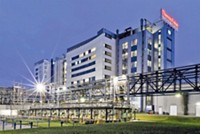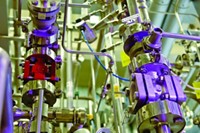Advertisement
Grab your lab coat. Let's get started
Welcome!
Welcome!
Create an account below to get 6 C&EN articles per month, receive newsletters and more - all free.
It seems this is your first time logging in online. Please enter the following information to continue.
As an ACS member you automatically get access to this site. All we need is few more details to create your reading experience.
Not you? Sign in with a different account.
Not you? Sign in with a different account.
ERROR 1
ERROR 1
ERROR 2
ERROR 2
ERROR 2
ERROR 2
ERROR 2
Password and Confirm password must match.
If you have an ACS member number, please enter it here so we can link this account to your membership. (optional)
ERROR 2
ACS values your privacy. By submitting your information, you are gaining access to C&EN and subscribing to our weekly newsletter. We use the information you provide to make your reading experience better, and we will never sell your data to third party members.
Business
Long-Term Partners
Case Study #2: A decadelong relationship is poised to yield a second polymeric drug
by Michael McCoy
March 4, 2013
| A version of this story appeared in
Volume 91, Issue 9

Late last year the California-based biotech firm Relypsa signed a multiyear agreement with Lanxess, owner of a German custom manufacturer of pharmaceutical and agricultural chemicals. The deal governs production of the active ingredient in Relypsa’s lead drug candidate and the filing of a New Drug Application with the Food & Drug Administration.
COVER STORY
Long-Term Partners
Although the agreement is new, the relationship between the two firms is anything but. Two of the key executives involved met and conducted their first business together fully 10 years ago.
Much has happened since then: A company was sold, a new firm was created, a promising drug was killed, and a key player left the stage—only to return in another role. But thanks to strong relationships among the people and organizations involved, an innovative new drug for the treatment of elevated potassium has moved steadily through the development pipeline.
The two executives, Gerrit Klaerner and Wilhelm Stahl, met in 2003. Klaerner worked for Ilypsa, a predecessor to Relypsa, and Stahl was employed by Saltigo, Lanxess’ custom manufacturing unit. Although they grew up not far from each other in Germany, their first encounter was in California, where Stahl was pitching Saltigo as a possible contract manufacturer for a promising Ilypsa compound.
Using high-throughput experimentation, Ilypsa had discovered an ion-exchange resin that helps patients with chronic kidney disease reduce phosphorus buildup in their bodies. Renagel, a polymeric drug marketed by Genzyme, already had been approved for that application and was pulling in hundreds of millions of dollars a year. But Ilypsa scientists believed their product, dubbed ILY101, could work just as well without the onerous doses—four 800-mg pills with each meal—that Renagel requires.
Saltigo was a natural fit for the manufacturing job. Lanxess, its parent company, was skilled at creating ion-exchange resins for industrial applications, and Saltigo could produce pharmaceutical chemicals to FDA specifications.
By 2005, Saltigo was making ILY101’s active ingredient at its facility in Leverkusen, Germany. It also started helping Ilypsa with the manufacture of a second polymeric drug, this one for the treatment of hyperkalemia, an elevated potassium condition that also affects patients with kidney disease.
In 2006, Ilypsa licensed ILY101 to Astellas Pharma for development in Japan. The following year, when Ilypsa was in the midst of Phase II clinical trials, it got the buyout that every biotech executive dreams of. Amgen, seeking medicines to complement its existing kidney disease portfolio, acquired Ilypsa for $420 million.
Klaerner, who was Ilypsa’s cofounder and chief business officer, might have been able to slow down after that, but he didn’t. “I get bored easily,” he says. Instead, in October 2007 he helped found Relypsa, a spin-off from Ilypsa formed to continue developing the potassium-binding polymer and other assets.
Relypsa got to work on the potassium-binding drug, now called RLY5016, or patiromer. And several other developments were taking place. In late 2008, Amgen stopped work on the phosphorus-binding polymer, despite good data from Phase II clinical trials. Stahl, meanwhile, left Saltigo to join Rondaxe, a pharmaceutical consulting firm.
The changes didn’t affect Relypsa, which in 2009 and 2010 posted favorable results from clinical trials involving patients with elevated serum potassium. Venture capitalists were impressed and showered the firm with cash. Stahl took notice as well. In the fall of 2011, he left Rondaxe to join Relypsa as senior vice president of pharmaceutical operations. His boss was Klaerner, who by then was Relypsa’s president.
Now on the same team, Klaerner and Stahl are bullish on patiromer and still happy with the manufacturing relationship with Saltigo. That partnership, which Stahl will oversee, is important because patiromer is poised to be taken by many people and in high doses compared with traditional small-molecule drugs.
Hyperkalemia, the disease that patiromer treats, afflicts patients with chronic kidney disease, particularly those who are taking drugs known as renin-angiotensin-aldosterone system (RAAS) inhibitors. In the U.S., Klaerner says, 14 million people suffer from stage three and four chronic kidney disease, mostly at the intersection of diabetes and hypertension. About 5 million of them could benefit from RAAS inhibitor therapy, were it not for the threat of hyperkalemia.
In an era of potent drugs administered in tiny doses, patiromer is a high-dose anomaly. Its strength is being a nonabsorbable polymer that does little in the body besides bind with potassium in the colon. And although it does this job well—better than 20,000 other polymers Relypsa considered—a lot of it may be needed: Doses in clinical trials range from 10 to 40 g per day.
The upshot is that a successful launch of the drug could require huge amounts of active pharmaceutical ingredient (API). Stahl “has come in-house because he is going to oversee what could be one of the larger volume API launches in the recent history of the pharmaceutical industry,” Klaerner says.
Of course, as for any drug in development, success is not yet ensured. Indeed, the fact that Amgen dropped development of ILY101, the phosphorus binder, casts a bit of a shadow over the potassium program.
Klaerner won’t comment on what might have prompted Amgen’s decision, but he notes that Astellas won approval for the drug in Japan last year. “That was a really important validation for us,” he says.
Moreover, Klaerner points out, whereas a new phosphorus binder must compete with Renagel and similar successful drugs, elevated potassium is a more prevalent problem with no satisfactory treatments.
Kayexalate, a potassium binder based on sodium polystyrene sulfonate, is a sandlike substance created by grinding up solid polymer. Because of its awful taste and unpleasant, potentially dangerous side effects, it is infrequently prescribed for kidney patients who need chronic care. Instead, RAAS inhibitors are typically withdrawn, to the detriment of patient health.
Patiromer doesn’t present these problems, according to Relypsa. The suspension polymerization process used to synthesize it yields smooth, micrometer-sized beads that are easy to swallow. “They almost flow like water,” Stahl says. He won’t disclose the actual compound, but patent literature suggests it’s a fluoroacrylate polymer cross-linked with divinylbenzene.
The person ultimately responsible for producing commercial quantities of patiromer is Wolfgang Schmitz, managing director of Saltigo. He oversees 10 custom manufacturing facilities at the Leverkusen site, one or more that will produce the polymer in preparation for market launch.
Schmitz likens the long and successful partnership between Saltigo and Relypsa to a good marriage. “You need to mutually understand the needs and the goals of the parties and make sure the relationship is sustainable and productive,” he says.
Patiromer’s size and high-dose demands makes it quite different from the small-molecule drugs that contract manufacturers normally synthesize, Schmitz acknowledges. But over the years, scientists from Saltigo and Relypsa have jointly developed and scaled up an efficient process for producing the polymer.
That relationship is going to be even more intimate now that Relypsa has launched a special abbreviated Phase III clinical trial and is looking ahead to filing a New Drug Application. Scientists from the two firms confer almost daily, according to Stahl. Problems are put on the table and picked up by those able to solve them. “Everyone talks about partnerships, but this is one that really works,” he says.
Unusual for a biotech firm, Relypsa intends to launch patiromer by itself—much like the biotech GelTex Pharmaceuticals did in the 1990s with Renagel. Genzyme later acquired GelTex for more than $1 billion. For Relypsa, the undertaking is sure to be full of challenges, but thanks to a 10-year partnership with Saltigo, API supply shouldn’t be one of them.





Join the conversation
Contact the reporter
Submit a Letter to the Editor for publication
Engage with us on Twitter